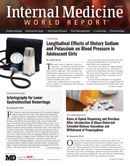Publication
Article
Internal Medicine World Report
Putting Words Into Action to Combat Antimicrobial Resistance
Author(s):
Antimicrobial resistance (AMR) may not be a new concept, but coming up with novel strategies to stop its progression is only becoming increasingly critical.

Antimicrobial resistance (AMR) may not be a new concept, but coming up with novel strategies to stop its progression is only becoming increasingly critical.
An estimated 700,000 deaths are caused by AMR annually worldwide with approximately 23,000 being in the United States. Those numbers are expected to climb significantly within the next few decades and the ongoing global burden has caused the creation of government initiatives and programs. Clinicians described the current challenges and future innovations in JAMA Internal Medicine.
“Antimicrobial resistance is the most urgent threat facing modern medicine,” Sara Cosgrove, MD, MS, vice president of the board of trustees of the Society for Healthcare Epidemiology of America, said in a news release. “While this is a multifaceted problem, creating and maintaining strong, effective antimicrobial stewardship programs across the healthcare continuum is essential.”
Researchers predict that 10 million people will die from antimicrobial resistance annually worldwide by 2050. Specific figures were broken down by region:
- North America: 317,000
- Latin America: 392,000
- Europe: 390,000
- Africa: 4,150,000
- Asia: 4,730,000
- Oceania: 22,000
In March 2015, the White House announced the National Action Plan for Combating Antibiotic-Resistant Bacteria. The agenda identified goals for the next five years including accelerating research and preventing the spread of the stubborn bacteria. It also aims to reduce inappropriate antibiotic use by 20% in inpatient care. In addition, the president’s fiscal year budget for 2016 requested $1.2 billion of federal funding to address AMR — which is nearly double the funds from last year.
“Much of the true innovation in antibiotic development right now is based in academic medical centers and small pharmaceutical and biotech companies,” Aaron Kesselheim, MD, JD, MPH, Harvard Medical School and Brigham and Women’s Hospital, said in the report.
Future incentives are already in place to combat this problem. For one, hospitals will begin measures associated with methicillin-resistant Staphylococcus aureus bacteremia and C difficile in 2017.
“Many of these initiatives involve working out basic science and epidemiology questions that remain unresolved and promoting cooperation across institutions and the government,” Kesselheim said.
The National Action Plan calls for at least 2 new antibiotics to move from preclinical testing to clinical trials as well as 3 new alternatives to antibiotics by year 2020. One of the antibiotic candidates, teixobactin, has shown to treat severe infections without adverse effects and is “essentially free of resistance,” according to senior author of the study Kim Lewis, PhD. Improvements will be made to teixobactin and the team plans to begin clinical trials. Furthermore, other researchers have been exploring effective antibiotic combinations to treat bacteria such as Escherichia coli.
The investigators stressed the importance of educating the public on AMR so they can consider limiting antibiotic use and being informed on the risks involved. This is an issue that falls on the lap of physicians and patients alike.
“We need to support this work with greater public investment and other tailored incentives that focus on antibiotics of high clinical need, but we also need systems in place to ensure rational use of the products once approved, or else we’ll never break the cycle we’re in now,” Kesselheim concluded.






